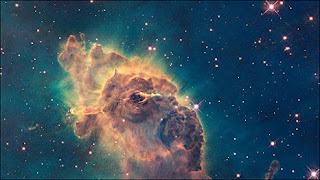Astronomers are celebrating the release of remarkable new images from the Hubble Space Telescope (HST).
They prove the mission carried out by astronauts in May to service the observatory was an outstanding success.
The latest pictures include trademark Hubble visions - from colliding galaxies to dying stars.
Nasa says the orbiting telescope, regarded as one of the most important scientific tools ever built, should keep working until at least 2014.
The Atlantis shuttle mission in May was the fifth and final Hubble makeover.
The US space agency and its international partners plan now to concentrate their efforts on preparing a bigger and more capable observatory known as the James Webb Space Telescope (JWST).
Wednesday's release of pictures was the usual tour de force that astronomers have come to expect following a Hubble servicing.
It included dazzling pictures of galaxies headed for a pile-up, a star throwing off its outer layers, dense clouds of gas and dust, and a new pin-sharp look at the planet Jupiter.
"Hubble is back in action," declared Dr Heidi Hammel, a senior research scientist at the Space Telescope Science Institute in Baltimore, Maryland, from where Hubble's mission is overseen.
"Together, Nasa and Hubble are opening new vistas on the Universe," she told a reporters.
The British astronomer Dr Paul Murdin, from the University of Cambridge, said the new images were breathtaking.
"My first reaction is 'my god, it all worked, it's fantastic'," he told BBC News"Refurbishment missions are always a little bit iffy because things can go wrong; astronauts can muck it up, maybe we didn't think about this or that when we redesigned the equipment, reinstalled it and refurbished it.
"But these images definitely show that Hubble is in good shape for what will be - unfortunately - its last few years.
"It's going to go out with a real bang."
The Atlantis astronauts conducted five spacewalks, to install new instruments and thermal blankets, to repair two existing instruments, and replace the telescope's gyroscopes and batteries.
Hubble is now more sensitive to light than ever before which should significantly improve its observing efficiency.
A key addition was the new Wide Field Camera 3. This is the instrument that many astronomers suspect will deliver the really big discoveries in the remaining operational years.
It will enable astronomers to carry out new studies of dark energy and dark matter, the "mysterious stuff" that makes up most of the Universe.
WFC3 will also allow Hubble to look deeper into space than ever before, to search for the very first stars to shine in the Universe more than 13 billion years ago.
One of the simpler tasks undertaken during the repair mission was to fit a docking ring that will serve as a point of contact with the defunct Hubble sometime after 2020.
A robotic mission will be sent to push the telescope back towards Earth and a fiery destruction in the atmosphere.
"Most of us humans will never travel to some of the exotic places physically that we see in these images," reflected Nasa's chief scientist, Ed Weiler
"What Hubble has done: it's enabled our hearts, our minds, our spirits to travel throughout the Solar System, even billions of light-years to the very beginning of time almost. And I think its ability to inspire at least some of our school kids to consider careers in engineering, science and math - that will be its most important legacy, not just keeping us astronomers happy.

In what was a prime mission objective, Hubble fixed the Universe's age at about 13.7 billion years - later confirmed by other instruments
Hubble's ability to detect faint supernovae contributed to the discovery that the expansion rate of the Universe is accelerating
Hubble was one of two telescopes to make the first direct images of planets orbiting another star - historic images made public last November
Hubble provided the first direct measurements of the three-dimensional distribution of dark matter in space
Hubble has shown that monster black holes, with masses millions to billions times the mass of our Sun, inhabit the centres of most galaxies












No comments:
Post a Comment